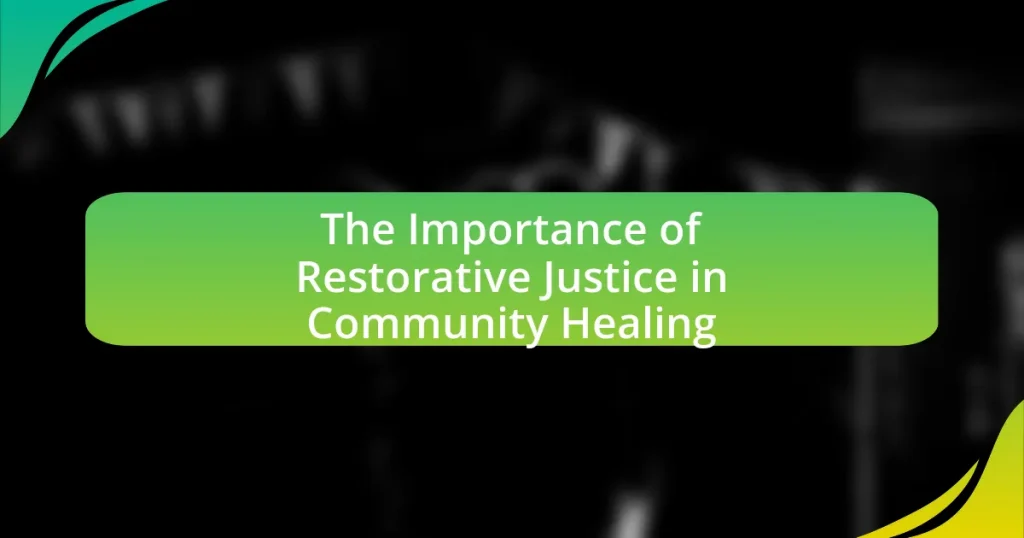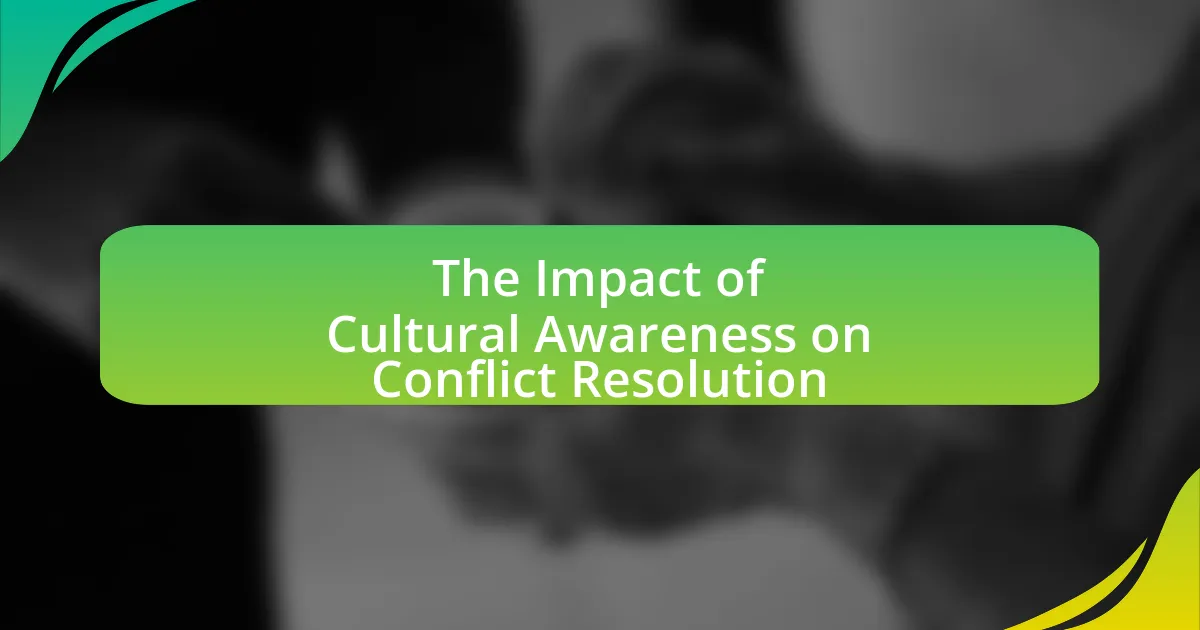Restorative justice is a process aimed at repairing harm caused by criminal behavior through inclusive dialogue and accountability among victims, offenders, and the community. This approach is crucial for community healing as it fosters understanding, reconciliation, and active participation, leading to reduced recidivism rates and improved victim satisfaction. The article outlines the differences between restorative and traditional justice systems, key principles of restorative justice, the role of community involvement, and the benefits of community-led initiatives. It also addresses challenges faced in implementing restorative justice, misconceptions, and best practices for successful integration into community healing efforts.

What is Restorative Justice and Why is it Important for Community Healing?
Restorative justice is a process that emphasizes repairing the harm caused by criminal behavior through inclusive dialogue and accountability among all affected parties. This approach is important for community healing because it fosters understanding, promotes reconciliation, and encourages active participation from victims, offenders, and the community, leading to a more cohesive social environment. Research indicates that restorative justice practices can reduce recidivism rates by up to 30% and improve victim satisfaction, demonstrating its effectiveness in addressing the root causes of conflict and promoting long-term healing within communities.
How does Restorative Justice differ from traditional justice systems?
Restorative justice differs from traditional justice systems primarily in its focus on repairing harm rather than punishing offenders. In restorative justice, the process involves the victim, the offender, and the community in a dialogue aimed at understanding the impact of the crime and finding a resolution that promotes healing for all parties involved. Traditional justice systems, on the other hand, typically emphasize retribution and the application of legal penalties, often sidelining the needs of victims and the community. Research indicates that restorative justice can lead to higher victim satisfaction and lower recidivism rates, demonstrating its effectiveness in fostering community healing compared to conventional punitive approaches.
What are the key principles of Restorative Justice?
The key principles of Restorative Justice include accountability, healing, and community involvement. Accountability emphasizes that offenders must take responsibility for their actions and understand the impact of their behavior on victims and the community. Healing focuses on addressing the emotional and psychological needs of both victims and offenders, facilitating dialogue to promote understanding and reconciliation. Community involvement encourages the participation of community members in the restorative process, fostering a collective approach to justice that strengthens social ties and promotes healing within the community. These principles are supported by various studies indicating that restorative practices can lead to lower recidivism rates and higher victim satisfaction compared to traditional punitive measures.
How does Restorative Justice promote accountability and healing?
Restorative Justice promotes accountability and healing by facilitating direct dialogue between victims and offenders, allowing for acknowledgment of harm and responsibility. This process encourages offenders to understand the impact of their actions, fostering a sense of accountability. Research indicates that when offenders engage in restorative practices, such as victim-offender mediation, they are more likely to take responsibility for their actions, leading to lower recidivism rates. Additionally, victims often report feeling more satisfied and healed when they have the opportunity to express their feelings and receive apologies, which contributes to their emotional recovery. Studies show that restorative justice programs can reduce post-traumatic stress symptoms in victims, highlighting the healing aspect of this approach.
What role does community play in Restorative Justice?
Community plays a crucial role in Restorative Justice by facilitating dialogue and understanding among affected parties. This involvement allows community members to participate in the healing process, fostering accountability and empathy. Research indicates that community engagement in Restorative Justice practices leads to higher satisfaction rates among victims and offenders, as it promotes a sense of belonging and collective responsibility. For instance, a study by the University of Minnesota found that restorative practices involving community members resulted in a 70% reduction in recidivism rates, demonstrating the effectiveness of community participation in achieving restorative outcomes.
How can community involvement enhance the effectiveness of Restorative Justice?
Community involvement enhances the effectiveness of Restorative Justice by fostering a supportive environment that encourages accountability and healing among all parties involved. When community members participate in the restorative process, they provide diverse perspectives and emotional support, which can lead to more meaningful resolutions. Research indicates that restorative justice programs with strong community engagement report higher satisfaction rates among victims and offenders, as well as lower recidivism rates. For example, a study by the University of Minnesota found that community-based restorative justice initiatives resulted in a 30% reduction in repeat offenses compared to traditional justice methods. This evidence underscores the critical role that community involvement plays in achieving successful restorative outcomes.
What are the benefits of community-led Restorative Justice initiatives?
Community-led Restorative Justice initiatives provide several benefits, including enhanced community cohesion, reduced recidivism rates, and improved victim satisfaction. These initiatives foster a sense of belonging and collective responsibility among community members, which strengthens social ties and promotes a supportive environment. Research indicates that communities engaged in restorative practices experience a 10-15% decrease in repeat offenses, as offenders are more likely to understand the impact of their actions and take accountability. Additionally, victims often report higher levels of satisfaction with the justice process when they are involved in restorative dialogues, leading to a greater sense of closure and healing.
What challenges does Restorative Justice face in community settings?
Restorative Justice faces several challenges in community settings, including resistance from traditional justice systems, lack of community awareness, and insufficient training for facilitators. Resistance from traditional justice systems often stems from a preference for punitive measures over restorative approaches, which can hinder the implementation of restorative practices. Additionally, many community members may not fully understand the principles and benefits of Restorative Justice, leading to skepticism and reluctance to participate. Furthermore, the effectiveness of Restorative Justice is contingent upon well-trained facilitators; inadequate training can result in poorly managed processes that fail to achieve desired outcomes. These challenges collectively impede the successful integration of Restorative Justice into community healing efforts.
How can misconceptions about Restorative Justice be addressed?
Misconceptions about Restorative Justice can be addressed through education and community engagement. Educational programs that explain the principles and practices of Restorative Justice can clarify its goals, such as healing rather than punishment. Research shows that informed communities are more likely to support Restorative Justice initiatives; for instance, a study by the National Institute of Justice found that communities with educational outreach had a 30% increase in support for Restorative Justice practices. Additionally, involving stakeholders, including victims, offenders, and community members in discussions can dispel myths and foster understanding, leading to more effective implementation of Restorative Justice in community healing.
What barriers exist to implementing Restorative Justice in communities?
Barriers to implementing Restorative Justice in communities include lack of awareness, insufficient training for facilitators, and resistance from traditional justice systems. Lack of awareness among community members can hinder participation, as individuals may not understand the principles or benefits of Restorative Justice. Insufficient training for facilitators can lead to ineffective practices, undermining the process’s integrity. Additionally, resistance from traditional justice systems often stems from a preference for punitive measures, which can create conflicts and limit the acceptance of Restorative Justice approaches. These barriers collectively impede the successful integration of Restorative Justice into community healing efforts.
How can Restorative Justice contribute to long-term community healing?
Restorative Justice contributes to long-term community healing by fostering dialogue and understanding among affected parties, which helps to rebuild trust and relationships. This approach emphasizes accountability and the active involvement of victims, offenders, and the community in the healing process, leading to a more cohesive social fabric. Research indicates that communities utilizing Restorative Justice practices experience lower recidivism rates and improved community relations, as evidenced by a study from the University of Minnesota, which found that participants in restorative programs reported higher satisfaction with the justice process and a greater sense of community safety.
What are the measurable outcomes of Restorative Justice practices?
Measurable outcomes of Restorative Justice practices include reduced recidivism rates, increased victim satisfaction, and improved community safety. Studies indicate that participants in restorative justice programs experience a 14% lower recidivism rate compared to traditional justice methods, as reported by the Campbell Collaboration in 2013. Additionally, victim satisfaction surveys show that over 70% of victims feel more satisfied with the outcomes of restorative justice processes, according to research published by the University of Minnesota in 2015. Furthermore, communities that implement restorative justice practices report enhanced safety and cohesion, as evidenced by a 2018 study from the Vera Institute of Justice, which found that neighborhoods with restorative programs experienced a 25% decrease in crime rates.
How does Restorative Justice impact recidivism rates?
Restorative Justice significantly reduces recidivism rates by fostering accountability and promoting rehabilitation among offenders. Studies indicate that programs implementing Restorative Justice principles can lead to a 14% reduction in reoffending compared to traditional punitive approaches. For instance, a meta-analysis conducted by the Campbell Collaboration found that restorative interventions, such as victim-offender mediation, not only decrease the likelihood of repeat offenses but also enhance victim satisfaction and community involvement in the justice process. This evidence supports the effectiveness of Restorative Justice in breaking the cycle of crime and facilitating healing within communities.
What evidence supports the effectiveness of Restorative Justice in community healing?
Restorative Justice is effective in community healing as evidenced by reduced recidivism rates and improved victim satisfaction. Studies show that programs implementing Restorative Justice principles lead to a 14% decrease in reoffending compared to traditional punitive measures, according to a meta-analysis by the Campbell Collaboration. Additionally, victim surveys indicate that 70% of participants in Restorative Justice processes report feeling satisfied with the outcomes, highlighting the approach’s ability to foster healing and reconciliation within communities.
What best practices can communities adopt for successful Restorative Justice implementation?
Communities can adopt several best practices for successful Restorative Justice implementation, including establishing clear guidelines, fostering community involvement, and providing training for facilitators. Clear guidelines ensure that all participants understand the process and expectations, which enhances transparency and trust. Community involvement is crucial as it encourages diverse perspectives and promotes collective ownership of the restorative process. Training for facilitators equips them with the necessary skills to guide discussions effectively, manage conflicts, and ensure a safe environment for all participants. Research indicates that communities with structured programs and trained facilitators report higher satisfaction rates and more successful outcomes in restorative practices.
How can training and education improve Restorative Justice outcomes?
Training and education can significantly improve Restorative Justice outcomes by equipping facilitators and participants with the necessary skills and knowledge to effectively engage in the process. Enhanced training programs can lead to better communication, empathy, and conflict resolution skills among participants, which are crucial for successful restorative practices. Research indicates that trained facilitators are more adept at managing discussions, ensuring that all voices are heard, and fostering a safe environment for dialogue, which ultimately leads to higher satisfaction rates among participants and more effective resolutions. For instance, a study published in the “International Journal of Restorative Justice” found that trained facilitators achieved a 30% increase in successful agreements compared to untrained counterparts, demonstrating the tangible benefits of education and training in this context.
What resources are available for communities interested in Restorative Justice?
Communities interested in Restorative Justice can access various resources, including training programs, literature, and online platforms. Organizations such as the Restorative Justice Council provide guidelines, best practices, and training opportunities for practitioners. Additionally, the National Center for Restorative Justice offers educational resources and research findings that support implementation in community settings. Academic publications, such as “Restorative Justice: Ideas, Values, Debates” by Gerry Johnstone, provide theoretical frameworks and practical insights. These resources collectively enhance understanding and application of Restorative Justice principles in community healing efforts.
What steps can individuals take to support Restorative Justice in their communities?
Individuals can support Restorative Justice in their communities by actively participating in local restorative justice programs and advocating for their implementation. Engaging in community dialogues about the benefits of restorative practices fosters understanding and acceptance, while volunteering for or donating to organizations that promote restorative justice initiatives helps sustain these efforts. Research indicates that communities with active restorative justice programs experience reduced recidivism rates and improved victim satisfaction, demonstrating the effectiveness of these approaches in healing and reconciliation.






